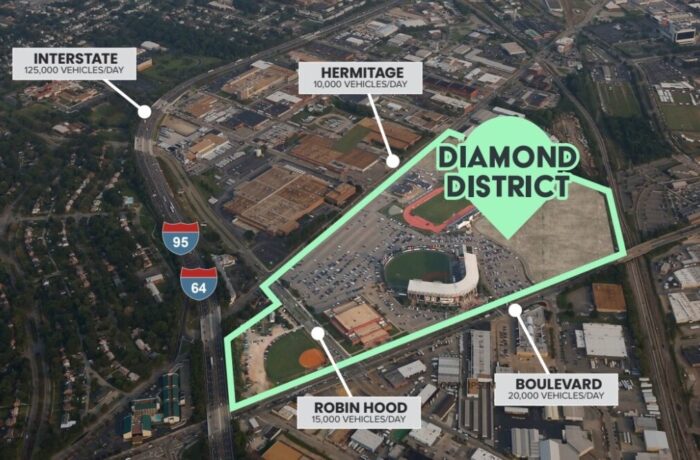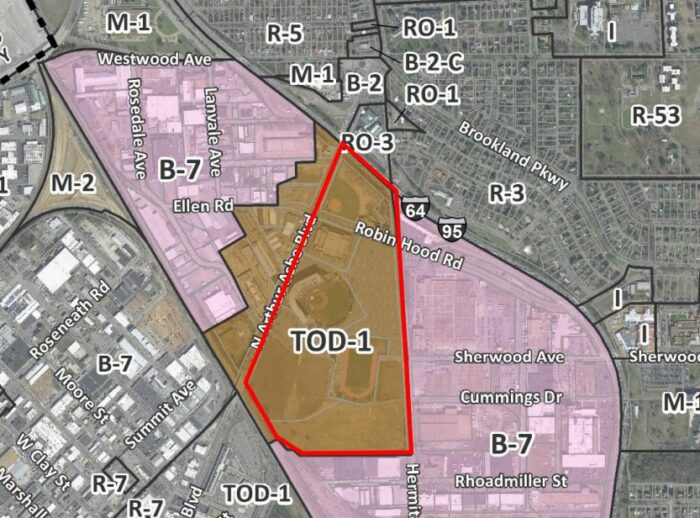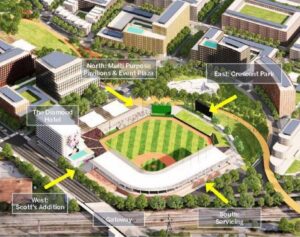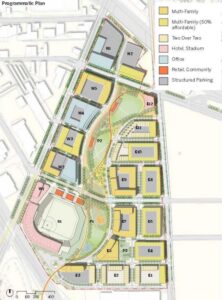
The 60-plus acres are bordered by Arthur Ashe Boulevard, Hermitage Road, the interstate and the railroad tracks. (File image courtesy City of Richmond)
With the timeframe getting tighter to deliver a new ballpark for the Richmond Flying Squirrels by the start of the 2025 baseball season, city planners are fast-tracking a next step in the process that would create a new zoning district specific to the stadium-anchored Diamond District project.
The Richmond Planning Commission on Monday declared its intent to amend the city’s zoning rules and map to create a so-called Stadium District that would be tailored to the massive mixed-use development.
The rezoning would include the 67-acre project site, which consists of The Diamond and other city- and VCU-owned land between Arthur Ashe Boulevard and Hermitage Road south of the interstate and north of the train tracks.
It also would include one privately owned property: a 0.8-acre parcel at 1700 Robin Hood Road that houses an RVA Financial Federal Credit Union branch.
The city had previously zoned the Diamond District site under its TOD-1 Transit-Oriented Nodal District as part of a larger area rezoning two years ago. The new Stadium District zoning would build off that classification with some additions and variations to accommodate the project, said Kevin Vonck, the city’s planning and development review director.

The Diamond District site was zoned TOD-1 as part of a larger area rezoning in 2021. (City documents)
While TOD-1 was initially envisioned as being suitable for the development, Vonck said the new zoning district is needed to allow specific components, such as a planned public-private park and the stadium itself.
“The framework for this will be TOD-1, with some things changed in it to reflect the nuances that are proposed in the development plan,” Vonck said at Monday’s meeting. “It should be pretty familiar, and I think that’s why we can propose something rather quickly.”
Planners are aiming to formally propose the new district in about a month, after a planned update on the project at the commission’s next meeting on Jan. 17.
The proposal would spell out what’s allowed in the Stadium District, though planners hinted at some during Monday’s discussion. One difference would be to allow up to 20 stories in building height, whereas TOD-1 puts a cap on 12 stories.
Another idea is to exempt the new stadium from the city’s signage rules, so as not to restrict the amount of signage allowed on the stadium, deputy PDR director Maritza Pechin said.

A rendering shows the new ballpark’s placement along with other components of the Diamond District’s first phase.
“We have a lot of it where we’re thinking through it, how we would do the signage and the parts that we want to change,” Pechin said, adding that staff had initially been crafting a special-use permit for the project. With the city initiating the rezoning and owning the bulk of the properties, she said a site-wide rezoning is more appropriate.
“We had been working on an SUP application for this, and then it became clear that that actually didn’t make any sense, that it made more sense to do a full-scale rezoning,” Pechin said. “It’s kind of the perfect candidate for a city-initiated rezoning, considering we do still own all of the property.”
Generally, according to Monday’s presentation, the Stadium District zoning would better align with initial development goals for the project that the City Council approved last fall with RVA Diamond Partners, the city’s development partner headed up locally by Thalhimer Realty Partners.
The council’s approval in September covered minimum business terms between the city and RVA Diamond Partners, as well as components of the $2.4 billion development’s first phase and financing, through a proposed community development authority using tax-increment financing.
In addition to the new ballpark, the first phase is to include at least 1,134 rental housing units, 20 percent of which would be lower-income rentals. Ninety-two for-sale residential units also would be built, with 20 percent of those aimed at lower-income households.
The phase would also include 58,000 square feet of retail, about 1,700 structured parking spaces and 50 surface spaces, a 180-room hotel, 4.2 acres of park space, and street and infrastructure improvements.
At buildout over four phases, the Diamond District is to total 2,863 rental units, 157 for-sale homes, 935,000 square feet of office, two hotels totaling 330 rooms, 195,000 square feet of retail, 6,800 structured parking spaces and 11 acres of park space, according to Monday’s presentation.
The city is aiming to deliver the new stadium by the start of the 2025 baseball season, the deadline set by Major League Baseball for all pro venues to meet new facility standards. The larger development is projected for completion over a 15-year period.
Still required to get the Diamond District in motion are the project’s definitive agreements, including sale of land, that remain in negotiations between the city and RVA Diamond Partners.
Thalhimer’s Jason Guillot, who’s leading the development team locally, said Monday that that process continues with drafting of legal documents, property surveying, schematic design for the ballpark and other first-phase development.
In an email, Guillot said the city’s administrative team is “actively engaged and have really rallied the troops at the City to make sure everyone is working together to bring this project to fruition.”
“We are meeting regularly with The Flying Squirrels organization as well as VCU on the ballpark programming and design, and they have been exceptional partners in this process,” Guillot said.
He added that the group hopes to introduce the project’s definitive agreements to the City Council “very soon,” describing the process as complex.
“There is a tremendous amount of complexity to the various legal documents and ordinances that must be drafted, and we’re all working together with our legal teams to get these wrapped up as soon as possible,” he said, “while also ensuring a high level of thoughtfulness and thoroughness as we plan a road map for the next ten to twelve years as this project gets built out.”
Meanwhile, the city also is tackling another economic development project: the 9-acre City Center project that would replace the Richmond Coliseum with mixed-use development. The city announced late last month that it had received five responses to a request for interest from developers for that project.

The 60-plus acres are bordered by Arthur Ashe Boulevard, Hermitage Road, the interstate and the railroad tracks. (File image courtesy City of Richmond)
With the timeframe getting tighter to deliver a new ballpark for the Richmond Flying Squirrels by the start of the 2025 baseball season, city planners are fast-tracking a next step in the process that would create a new zoning district specific to the stadium-anchored Diamond District project.
The Richmond Planning Commission on Monday declared its intent to amend the city’s zoning rules and map to create a so-called Stadium District that would be tailored to the massive mixed-use development.
The rezoning would include the 67-acre project site, which consists of The Diamond and other city- and VCU-owned land between Arthur Ashe Boulevard and Hermitage Road south of the interstate and north of the train tracks.
It also would include one privately owned property: a 0.8-acre parcel at 1700 Robin Hood Road that houses an RVA Financial Federal Credit Union branch.
The city had previously zoned the Diamond District site under its TOD-1 Transit-Oriented Nodal District as part of a larger area rezoning two years ago. The new Stadium District zoning would build off that classification with some additions and variations to accommodate the project, said Kevin Vonck, the city’s planning and development review director.

The Diamond District site was zoned TOD-1 as part of a larger area rezoning in 2021. (City documents)
While TOD-1 was initially envisioned as being suitable for the development, Vonck said the new zoning district is needed to allow specific components, such as a planned public-private park and the stadium itself.
“The framework for this will be TOD-1, with some things changed in it to reflect the nuances that are proposed in the development plan,” Vonck said at Monday’s meeting. “It should be pretty familiar, and I think that’s why we can propose something rather quickly.”
Planners are aiming to formally propose the new district in about a month, after a planned update on the project at the commission’s next meeting on Jan. 17.
The proposal would spell out what’s allowed in the Stadium District, though planners hinted at some during Monday’s discussion. One difference would be to allow up to 20 stories in building height, whereas TOD-1 puts a cap on 12 stories.
Another idea is to exempt the new stadium from the city’s signage rules, so as not to restrict the amount of signage allowed on the stadium, deputy PDR director Maritza Pechin said.

A rendering shows the new ballpark’s placement along with other components of the Diamond District’s first phase.
“We have a lot of it where we’re thinking through it, how we would do the signage and the parts that we want to change,” Pechin said, adding that staff had initially been crafting a special-use permit for the project. With the city initiating the rezoning and owning the bulk of the properties, she said a site-wide rezoning is more appropriate.
“We had been working on an SUP application for this, and then it became clear that that actually didn’t make any sense, that it made more sense to do a full-scale rezoning,” Pechin said. “It’s kind of the perfect candidate for a city-initiated rezoning, considering we do still own all of the property.”
Generally, according to Monday’s presentation, the Stadium District zoning would better align with initial development goals for the project that the City Council approved last fall with RVA Diamond Partners, the city’s development partner headed up locally by Thalhimer Realty Partners.
The council’s approval in September covered minimum business terms between the city and RVA Diamond Partners, as well as components of the $2.4 billion development’s first phase and financing, through a proposed community development authority using tax-increment financing.
In addition to the new ballpark, the first phase is to include at least 1,134 rental housing units, 20 percent of which would be lower-income rentals. Ninety-two for-sale residential units also would be built, with 20 percent of those aimed at lower-income households.
The phase would also include 58,000 square feet of retail, about 1,700 structured parking spaces and 50 surface spaces, a 180-room hotel, 4.2 acres of park space, and street and infrastructure improvements.
At buildout over four phases, the Diamond District is to total 2,863 rental units, 157 for-sale homes, 935,000 square feet of office, two hotels totaling 330 rooms, 195,000 square feet of retail, 6,800 structured parking spaces and 11 acres of park space, according to Monday’s presentation.
The city is aiming to deliver the new stadium by the start of the 2025 baseball season, the deadline set by Major League Baseball for all pro venues to meet new facility standards. The larger development is projected for completion over a 15-year period.
Still required to get the Diamond District in motion are the project’s definitive agreements, including sale of land, that remain in negotiations between the city and RVA Diamond Partners.
Thalhimer’s Jason Guillot, who’s leading the development team locally, said Monday that that process continues with drafting of legal documents, property surveying, schematic design for the ballpark and other first-phase development.
In an email, Guillot said the city’s administrative team is “actively engaged and have really rallied the troops at the City to make sure everyone is working together to bring this project to fruition.”
“We are meeting regularly with The Flying Squirrels organization as well as VCU on the ballpark programming and design, and they have been exceptional partners in this process,” Guillot said.
He added that the group hopes to introduce the project’s definitive agreements to the City Council “very soon,” describing the process as complex.
“There is a tremendous amount of complexity to the various legal documents and ordinances that must be drafted, and we’re all working together with our legal teams to get these wrapped up as soon as possible,” he said, “while also ensuring a high level of thoughtfulness and thoroughness as we plan a road map for the next ten to twelve years as this project gets built out.”
Meanwhile, the city also is tackling another economic development project: the 9-acre City Center project that would replace the Richmond Coliseum with mixed-use development. The city announced late last month that it had received five responses to a request for interest from developers for that project.


My goodness, one would think the fast-tracking of the zoning changes would have started the moment a winning developer was announced for the Diamond District. Or the zoning could have been accomplished by the time the winner was announced. I am pro-Richmond and believe city officials try to do what is best, but this project was planned for years. To only begin the re-zoning process now seems to be poor planning and execution.
Considering they might want to incorporate the winning entry into the details of the zoning it makes perfect sense to wait till after it is awarded to do the zoning. Additionally working with the winning bidder after the award to come up with an even better scope leads us to this timeline. Developments this large do not happen overnight. The fact that it has even gotten this far along is a good sign compared with previous developments for a ball park. They could have done zoning before but chance are they would have had to come back and do it… Read more »
Where did the 20-story apartment building idea come from? Has anyone thought about the so called all electric future of the automobile? How many charging stations will be needed and where will they go? What about the density on “game days?” Where will the people who will be attending the games park?
What exactly will be driving the desire to live in the Diamond District if accessibility, and convenience is lessened?
John is correct about the rezoning. It should have been completed by now, not being started now!
I’m willing to bet that the idea for the added height is from the developer thereby lessening the sprawl aspect and providing more garage shared parking opportunities. Details for charging stations can be incorporated within construction plans and needn’t be addressed within the zone change timeline. This rezoning can be knocked out quickly at the City Council level.
Here we go again, Brian. 🙄 Respectfully, why do you find a 20-story apartment building (or several of them, for that matter) to be so problematic? As Bruce mentions in his response, added height can lessen the sprawl aspect of the overall development. As for charging stations, I believe current zoning regulations already on the books require those to be integrated into physical structures. As for things like charging stations, accomodating fans coming to the ballpark on gamedays, etc., what say we give the developers — who know a heck of a lot more about these kinds of things than… Read more »
What would we do without your novel questions that I’m sure no one has thought of yet? /eyeroll
Not opposed to the rezoning but as other said kind of funny but probably the thought was to adjust the zoning to the final needs once the deal is done but the City is so behind on getting the agreement for the project completed they need to rush through the rezoning. PS to be open in 2025 for a season it needs to be ready for set up by the team come Dec 2024 to allow them to be ready 90 days out before MiLB spring training starts March 1, 2025. Tick tock City Hall!